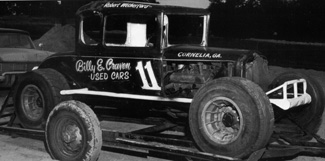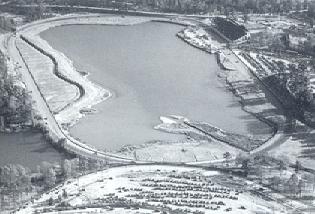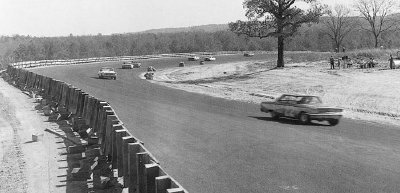
Mike Bell
By Mike Bell
Posted in Columns 2/25/11
A guy from Michigan by the name of Alan Brown has compiled a list of all the race tracks that ever existed in North America, entitled “The History of American Speedways: Past and Present.” He shows every track that is known to exist but knows he hasn’t made a complete list.
I have tried to help him update his book. I do this by looking through numerous microfilms of newspapers at the University of Georgia. Thanks to their School of Journalism, there are films of papers from throughout this state. So far, I have gone through papers for Macon, Columbus, Athens, Augusta, Gainesville, Albany and other cities.

Robert Weatherford's #11 sits on the trailer waiting to race sometime in the mid sixties.
Some of you may have seen recently information on the old Gainesville Speedway that Max Looper built in 1947-48. It is now under Lake Lanier, but when the water level is low enough, you can see the concrete grandstands. That track gained nationwide attention a couple of years ago during Georgia’s drought.
But what happened to the hundreds of speedways in Georgia that no longer exist? Allan Brown’s book tries to give us a way to remember this track.
Fellow Georgia historian Joe Cawley, of Augusta, wanted at one time to publish a book with photos from every track in Georgia. The only problem Joe had was that every time he collected pictures from one track he would find about three more that had existed in out state.
Everyone connected with racing from the past knows about Lakewood Speedway in Atlanta and the long history it has, but will the next generation know anything about the site except that it is a place to go and listen to music? More drivers probably gave their lives to advance out sport at that racetrack than any other in the south and maybe in the nation. Shouldn’t someone remember these people?
Right after World War II, Lakewood promoter Sam Nunis presented a program of Indy Car racing at the track on Labor Day of 1946. George Robson, the 1946 Indy 500 winner, and George “Tex” Barringer lost their lives on the Atlanta mile that day. John Earl “Skimp” Hersey died after he was involved in what was probably the most gruesome accident that has ever taken place in America in 1950. Charles Brinkley died in March of 1950 in another accident at an earlier modified event. An up and coming driver by the name of Mike Joseph of Philadelphia died in the early 1950s at the south’s most notorious speedway.

Atlanta's Lakewood Speedway is a legendary track that, unfortunately, saw it's share of tragedy.
Prior to WWII, an Atlanta driver by the name of Johnny Argo lost his life in a program for local racers. Motorcycle racers have not been exempt from tragedy at Lakewood either. A rider from Greenville, South Carolina, who went by the name of Easy Pickens, lost his life at Atlanta’s one mile dirt oval, which was designed for horse racing) in 1917. Should these men be forgotten?
There have been numerous racetracks in Georgia that have claimed lives. The Peach Bowl Speedway, located in Atlanta, ran for some 22 years with only two fatalities, which occurred in the early years. The Dodge County Fairgrounds in Eastman took a couple of lives before the fair board closed the track. I was at Valdosta ‘75’ Speedway in 1962 when Hulon Jones of Tallahassee, Florida vaulted over Larry Strickland’s rear wheel, flipping his Ford coupe. Jones died at a nearby hospital.
The sports editor of the Macon News quit covering racing after Bunk Ezzell was killed at Warner Robbins’ nine-sixteenth oval. He wrote a lengthy editorial telling the local people that he could no longer support our sport after what happened to Ezzell. A lot of newspapers in Georgia took the same attitude, and this makes finding information on the tracks very hard.
In Vidalia in the late forties and early fifties, they ran a racetrack near the local airport but there is nothing in their local paper on its existence. Rome’s newspaper would run the advertisement for the local oval, Chulio Speedway, but there never were any results of what happened at the speedway in the paper. Albany had two speedways running at the same time on opposite sides of town, Albany Speedway and Suicide Circle, but very little on what happened was ever written, even when the National Stock Car Racing Association came to town with their modifieds.
A lot of problems of early coverage of racing events can be laid at the feet of the promoters. Most of these small towns throughout Georgia had weekly or twice weekly newspapers. Their staff never consisted of a sports writer. The sports that appeared in the pages came off the news wires. Workers would take these stories and set them to print.
Some early promoters realized this and wrote their own coverage, while others did not. Sam Nunis, probably one of the greatest promoters this nation has ever seen and a native of Cedartown, Georgia, would send someone to the town where his next promotion was going to be presented to make sure there was coverage of a Sam Nunis Promotion in the local paper. I have been told sometimes these workers never saw the races but went on to the next town the day the race was held. But still the newspapers are out greatest resource for the history of racing in Georgia.
Through newspapers, I have found tracks in Jesup, Waycross (in 1951, 1952 and 1953), Douglas (although Wilbur Collins of Jacksonville, Florida, told me it really existed), Montezuma, Cordele (at Memorial Park outside of town), Jasper (which Jack Jackson said was a circle), Lavonia (Wendell Roach said it was a terrible track but they still raced on it), Hollywood, a horse track in Calhoun, and even Fort Oglethorpe near Chattanooga. What went on at these tracks may be lost forever, as there were ads for races but no results for some.

Fireball Roberts charges around the three-mile Augusta road course in the only NASCAR event held at the track in 1963. Roberts would go on to win the event.
Augusta had more racetracks than any city in Georgia. First there was Augusta Speedway in 1947, and then a horse track was converted and called Garden City Speedway. There was a midget track called Speedway Park, a little quarter mile in the lines of the Peach Bowl. Like the Peach Bowl, Speedway Park was paved in the early fifties and still exists today, though no racing is run on it.
In 1956, they built Overnite Race Track, also on in the suburb of Martinez. Across the river in Aiken, South Carolina, off a road aptly named Whiskey Road, a d-shaped half-mile ran in the mid-fifties.
Augusta International Speedway opened in the early sixties. This was a very ambitious project that included a drag strip and a road course. Actually, a NASCAR Grand National event ran on the road course, and was won by Fireball Roberts. It marked the final win of his career. All these closed before the end of the sixties. The presently running dirt track was built on the site of the original Augusta Speedway.
Other lost tracks would include Turner County Speedway near Ashburn, a Rome Speedway built in 1949 out on the road to Calhoun and Dalton, Cherokee Motor Speedway, where Bud Lundsford probably had his worst wreck. Then there’s Columbus Super Speedway, which was another track like the Peach Bowl, and Macon Speedway, run by former racer Jesse James Taylor. There’s Pavo or Patton Speedway in south Georgia. There’s the two racetracks in Albany, Albany Speedway and Suicide Circle. There’s the several Savannah Speedways, or Dunn’s Speedway in Baxley, which was also D-shaped, or New Atlanta Speedway near Jonesboro, so named because there was an Atlanta Speedway, a full half mile track, built where Paces Ferry Road crossed the Chattahoochee River in North Atlanta in 1929.
And I’ve only worked with racing since World War II. Ever wonder how much racing was run before the War? How about beach racing at Sea Island near Brunswick or midget racing at the stadium near Mercer University in Macon or near Session Lake in or near Dublin, not to mention the winder series run at the fairgrounds in Savannah, which started Christmas Day 1935 and ran through 1939.
In Allan Brown’s book, mention is made of racing in Occilla in 1934. So there’s still plenty of racing history left to uncover in Georgia’s past.
Editors note: Portions of this story originally appeared in the March 1998 issue of the Pioneer Pages magazine.
Mike Bell is the CEO and historian for the Georgia Auto Racing Hall of Fame Association, Inc. (GARHOFA)
Questions, comments, suggestions? Email us!
This website is not affiliated with or endorsed by the Georgia Racing Hall of Fame or the Georgia Auto Racing Hall of Fame Association, Inc. All content is the intellectual property of the individual authors. All opinions are those of the individual authors. Please do not repost images or text without permission.
